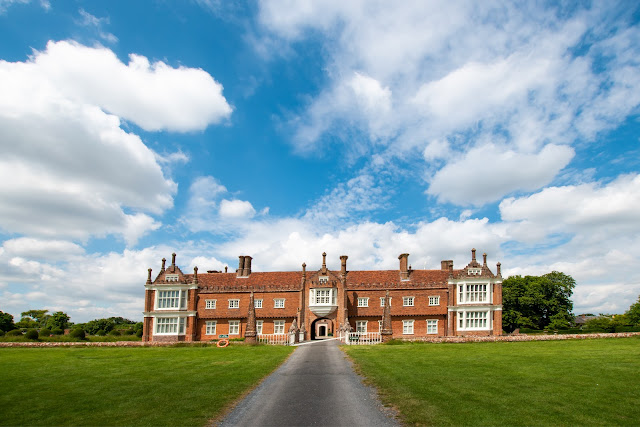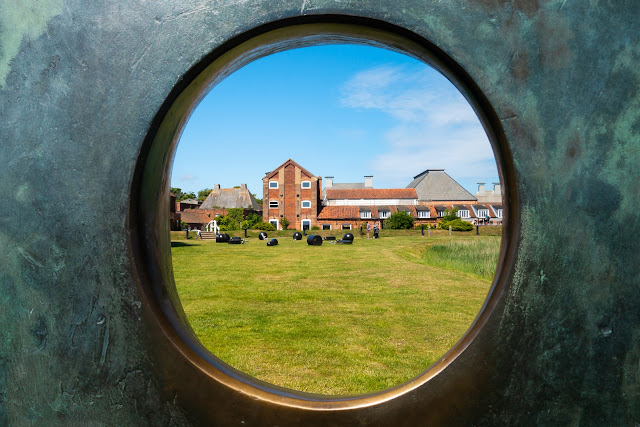Any trip to Northumberland must include time on Lindisfarne or Holy Island as it is known. Obviously it has a long and varied history, but also it's a wonderful island to just follow the footpath around the coastal edge and marvel at the wildlife and soak up the peace and tranquility.
We have visited the island before, but a re-visit was today's objective - tides permitting!
Lindisfarne Castle is really two buildings; the comfortable Edwardian holiday home with the Lutyens features and the cosy atmosphere is the obvious one as it is what we see today. But hiding behind all this is the old fort, dating from Tudor times and taking up three quarters of the Castle's history.
Lindisfarne Castle as we know it first appears in about 1550, but wasn't in any completed state until 1570. For the next three hundred years, the fort (as it was known then) was home to temporary garrisons of soldiers on detatchment from the larger force based at nearby Berwick. Their main job was to man the guns, watch the horizon for trouble, and try and stave of boredom with gunnery practice. Aside from a couple of incidents, the Castle could be said to have had a quiet military history through this period. The fact it was still standing when Edward Hudson discovered it in 1901 is testement to that. His friend the architect Edwin Lutyens was soon to dramatically change the building over the next few years, from a fort to a holiday home.
Many of the features of the old fort were lost during the Lutyens renovation of 1903-1906 but if you delve a little deeper and don't accept what you see in front of you, parts of the old building reappear before you. It does require some imagination I can vouch!
In the Dining Room, for example, Lutyens created a new fireplace, laid a distinctive herringbone brick floor and carved out a huge window bay with tracery window in stone. He left untouched a bread oven and salt hole from the soldier's time (probably dating from the 16th-century) along with the low vertical walls which are about as old as anything in the Castle. The vaulted ceiling, installed in the 18th-century to bear the weight of a new gun battery above.
Elsewhere there is the original staircase leading to the Upper Battery is a prominent feature along with the low ceilings of the western end of the building, and the surviving Victorian doors leading to the former gunpowder magazine - Lutyens' West Bedroom.
The holiday home from the early twentieth century is the building most on show, and we tell the story of those who worked here, those who visited, and those who called the place home over a hundred years ago. For the best part of seventy years, Lindisfarne was so much more to so many people than a old fort on a crag.
Having taken images of these upturned boats, come sheds, on our previous trip in 2009, this time I took one of the more `used` ones.
A display of Red Valerian as seen from the castle path.
View of the village, priory ruins and harbour from the castle.
The lime kilns at Castle Point are a Scheduled Ancient Monument – a designation made in recognition of the national significance of the site. They are some of the largest examples of their kind anywhere in the country and certainly the largest actively-conserved kilns in the area.
Have the kids been busy? - piles of stones on the foreshore.
One of a series of `willow` wildlife dotted around the island.
A series of eight larger-than-life willow sculptures have taken up residence on points around the Lindisfarne Nature Trail. The sculptures were created by local artist and willow sculptor Anna Turnbull with help from 40 volunteers. The sculptures depict key species of the Lindisfarne National Nature Reserve, managed by Natural England, and include Brent Geese in flight, a creche of two female Eider ducks and their chicks and a flowering Lindisfarne Helleborine orchid.
The sculptures are situated on the Lindisfarne Nature Trail, a circular walk of approximately 3 miles, that loops from Holy Island village along to the Castle, then follows the former limekiln waggon way to the dunes of The Links. The trail returns to the village via the Straight Lonnen
Silverweed, and there was a lot of it about, is a creeping, trailing plant that can be found on rough grassland, roadside verges, sand dunes and waste ground. Its yellow flowers appear between June and August among the creeping mats of its silvery, downy leaves which remain all year-round.
Big sky with glorious clouds.
This white granite pyramid was one of the first daymark beacons built on mainland Britain. It was built between 1801 and 1810 by Trinity House.
The oldest building on Holy Island, the church of St Mary The Virgin. The only building that retains work from the Saxon period.
The interior of the Parish Church of Saint Mary the Virgin
The original wooden version of `Journey` in St Mary`s church.
"Journey" is a wooden sculpture, carved from seven elm trees, by Fenwick Lawson (1999). The sculpture depicts the monks of Holy Island carrying the coffin of St. Cuthbert to safety and eventual rest in Durham Cathedral, c.875 AD, when Viking raiders threatened the island. The sculpture was exhibited in Durham Cathedral for a time and proved popular. Local people raised funds for a bronze casting of Journey, and this now stands in Millennium Square, in Durham.























































